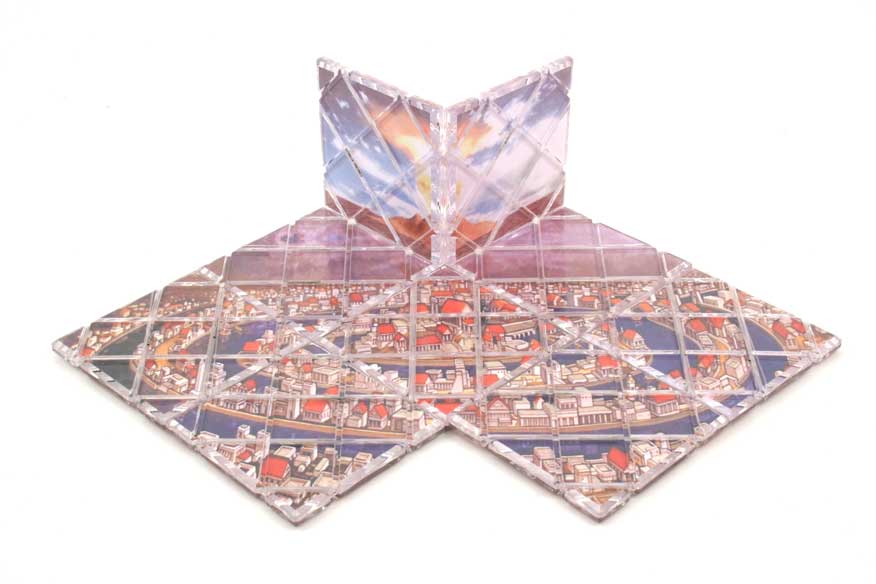
Figure 1: The Secret of Atlantis Puzzle (made of nine square double
plates).
"Thousands of years ago, there existed a
powerful civilization, whose residents became very corrupted by greed
and power, and were destroyed by the wrath of Zeus, the King of the Olympians
Gods. Until today, historians and explorers are still trying to answer
the questions of what happened to the lost continent of Atlantis and how
it disappeared. The answer is simple. Atlantis still exists, but has shrunk
into a small puzzle. This is the secret of Atlantis... a puzzle that holds
within it a legend of infinite knowledge..."
Introduction
The author always felt that the folding mechanism based on the Rubik's Magic is brilliant, and despite the great marketing of the past, not much justice had still been done to show its proper potential to the world. It was the main reason the author have made dozens of mechanically different designs, as well as adaptation of a variety of mathematically efficient themes.
The general family of puzzles are defined as FP (folding plate). In the past, all commercial square FP puzzles used a number of tiles which was a multiple of four. After searching a bit, I found out that a few square FP puzzle experts have created slightly different designs. Juozas Granskas had done different types with six, seven (by "bandaging" two 4-tile FP puzzles), and ten tiles. Adam Cowan did FP puzzles with six and ten tiles, and Tim Browne created a mini 6-tile FP puzzle.
It is essential to divide those FP puzzles into three categories:
1. Closed Loop FP
puzzles, such that each tile is connected to exactly two neighbour tiles,
2. Open Loop FP puzzles, such that at least one tile is connected to only
one neighbour tile, and
3. Bandaged Loop FP puzzles, such that at least one tile is connected
to more than two neighbour tiles.
Based on the author's personal experience, a difficulty "Level" number (using a 1-10 scale - 10 is the hardest) is shown. For the Square Tile Closed Loop FP puzzle mechanism (which is found in the majority of the FP puzzles) the notation M(x,y,z) is used as defined in the FP puzzle classification article [Pantazis Constantine Houlis, A classification of Folding Plate Puzzles, CFF 78, March 2009, pp. 4-9]. The first letter "M" of the notation was derived from the word "Myth", denoting their rare nature (it can also be assumed to be the word "Magic"). All of those puzzles are hardly available today, as only a limited number (or none at all) of copies had been made. This article documents this effort as it is certain that in the future it will inspire more new findings.
The Folding Plate Puzzle List
1. Build the Color Bench.
Level: 5. Type: M(8,0,0).
This puzzle is a colored variation of the Build the Bench puzzle. The
colors were specifically made to match in the solved state (eight colors
in total).
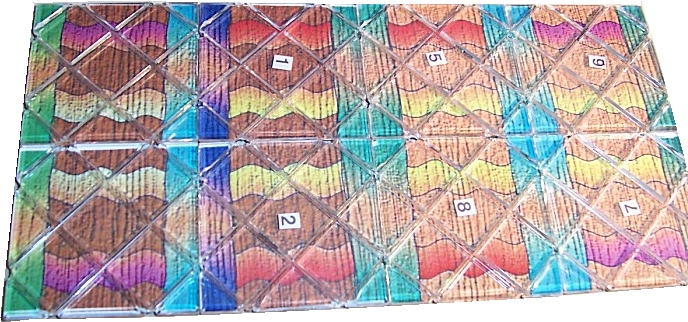
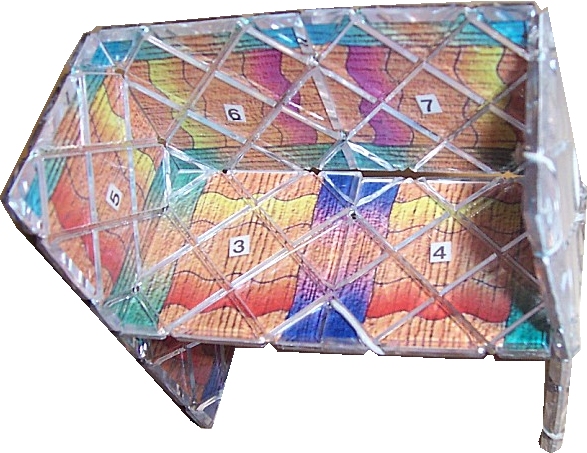
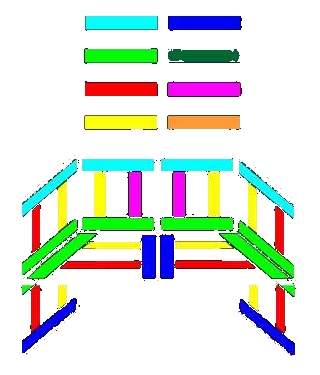
Figure 2: Unsolved and solved states of the Build the Bench Puzzle, and the color configuration which is being used.
Six of the paper tiles use a bright wooden background, and ten have a
dark. This ensures that the inside (sitting) part of the bench has a bright
colored background, while the outside has a dark, providing a unique solution.
2. The Magic Olympic Challenge (full set).
Level: 4,8,9. Type (only for the Golden Olympic Challenge): M(10,0,0).
Figure 3: Bronze, Silver, and Golden Magic Olympic Challenges.
The Magic Olympic Challenge consists of three (maze themed) FP puzzles
made of seven, nine, and ten tiles, and named as Bronze Challenge, Silver
Challenge, and Golden Challenge respectively.
The Bronze Olympic Challenge is a Bandaged Loop FP puzzle made of two four-square-tile Closed Loop FP puzzles which share one tile (so in total it has seven tiles). The bandaging creates an extra challenge for the puzzle solver. Juozas Granskas was the first to make the mechanism found in this puzzle, by using a different theme [4].
The Silver Olympic Challenge is also a Bandaged Loop FP puzzle. This time it is made of two six-square-tile Closed Loop FP puzzles which share three tiles (so in total it has nine tiles). Since the number of shared tiles is high, solving can sometimes lead to dead ends. It is one of the trickiest FP puzzles ever made.
The Golden Olympic Challenge is a Closed Loop FP puzzle made of ten tiles. Its freedom of movement (compared to the Bronze and Silver Olympic Challenges) makes solving more difficult, as the choices are much more and the solution is unique.
3. Magic Dino Cube. Level: 7. Type: M(6,0,0).
This 6-tile Closed Loop FP puzzle depicts a theme based on the extremely
rare twisty puzzle Magic Dino Cube. By definition, this puzzle works differently.
There were four known versions of the rare twisty puzzle, and here we
are using two of them (one for each side), the "plain-color"
side with four colors, and the "dinosaur color" side with six
colors.
Figure 4: Top: Flat state, unsolved cubic state, and solved cubic
state of the "plain color" side.
Bottom: Flat state and solved cubic-state of the "dinosaur color"
side, and the starting point
of the "plain color" side which
leads to a solved cubic state.
Finding a flat solution is always easier than finding a solution which
has a 3D form (as seen in the Build the Bench puzzle). But what if going
to the 3D form is already a puzzle? Unlike the Magic Maze which used the
same mechanism with the Magic Dino Cube, here we need to follow a mesmerizing
sequence which the author named as the "Secret Cube Move" (see
image sequence below).
This Secret Cube Move sequence (which needs extra care when performed) starts from the flat state and ends to the cubic state. Depending on the starting point (as there are many flat states), the cubic state result can be manipulated accordingly. When going from "flat to cubic" state or from "cubic to flat" state, the FP puzzle will automatically snap without any bad effects. But like all FP puzzles, after performing a tight move, it is good to check all strings are in place.
In general, the Magic Dino Cube is actually two cubes (which means that the puzzle has two cubic solutions), one of which represents the four colored Dino Cube (front side when flat), and the other represents the six colored Dino Cube with the dinosaur pictures (back side). In the back side, four colored lines have been added on each side of the square, to denote the color of the tile that is supposed to be adjacent to the other when solved. This proves the importance on detail which is combined with providing a unique solution for both sides.
4. Pantazis Color Magic Box. Level: 8. Type:
M(7,0,0).
"After the enigma of the Sphinx was solved, the Gods were furious as their best puzzle was revealed to mortals. Thousands years later, and after thinking carefully of how to punish the ever curious humans, they sent to them a small magic puzzle, which was made of seven tiles that symbolised that the magic box was more powerful than all the seven wonders of the ancient world put together".
This puzzle is more flamboyant version of the Pantazis'
Box using the properties of the transparent tiles. Here, accurate tools
were used to nicely cut the glittery paper inserts such that after the
box shape is formed, we can see through as many as three tiles in a row.
There are four types of punched cuts, each of which represents summer
(sun), autumn (leaf), winter (snowflake), and spring (flower). Special
calculations were made to ensure the existence of exactly two solutions.
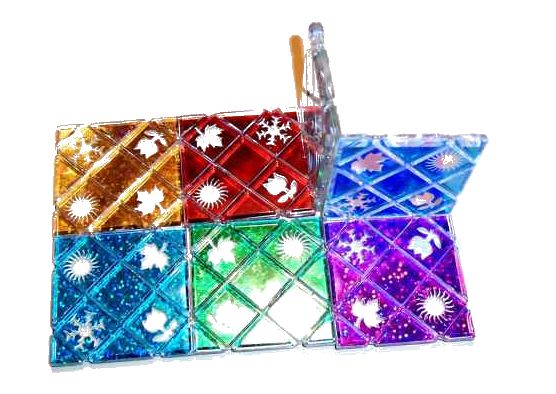
Figure 5: Top: Unsolved state. Bottom: Solved and unsolved "boxed
states".
In one of the solutions, the autumn symbol is on the top-left and when
looking inside the box and all four symbols can be clearly seen through
the three bottom tiles. But beware, there are two states, one that will
make you powerful (which was just shown), and one that will bring total
destruction to the world. Play this puzzle on your own peril!
5. Throne of Gods. Level: 10. Type: M(5,0,0).
This 5-tile Closed Loop FP puzzle is called as Throne of Gods, because
it can take the shape of a throne, and it can only be solved by…
Gods! The (unimaginable) goal here is to reach a cubic shape (with one
side missing) such that the line is continuous along all sides and tiles
(inside out).
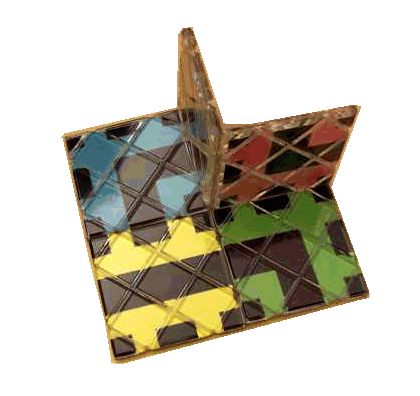
Figure 6: Unsolved and solved states of the Throne of Gods.
To reach the solution, three extremely risky secret moves are required
(which test the elasticity of the strings to their limit). And this is
the reason why this puzzle is regarded as one of the most difficult of
all puzzles made by the author. It is strongly advisable that the above
puzzle is solved by FP puzzle experts. In fact, this puzzle was very much
enjoyed by Erno Rubik himself during the author's visit to Hungary (Rubik's
Studio) in 2009.
6. Magic Octopus. Level: 5. Type: Open Loop.
The Magic Octopus is a 12-tile Open Loop FP puzzle, very different from
all the other 12-tile FP puzzles made. As it can be seen from the above
picture, it is in fact, a single loop 4-tile FP puzzle, where each of
the eight outside sides has an additional (tentacle) extension.
Figure 7: Unsolved and solved states of the Magic Octopus.
For this puzzle to be solved, you need to know very well how to solve
a 4-tile FP puzzle, as it will require a few more tricky moves to make
sure the tentacle-extensions won't get tangled with each other!
The goal of the puzzle is simple. When irritated, the octopus becomes red and prepares to use their ink to escape. The puzzle solver is required to "calm down" the octopus by unscrambling the blue color (which will scramble the red color).
7. Secret of Atlantis. Level: 9. Type: M(9,0,0).
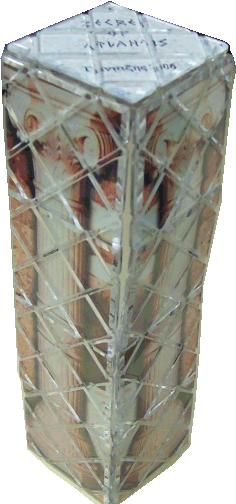
Figure 8: Solved (Corinthian columns) and unsolved (City of Atlantis)
states of the Secret of Atlantis Puzzle.
At the very first photo of the article, we may see the solved state of
the City of Atlantis. The goal is to go from one solved state (Corinthian
columns) to the other (City of Atlantis). When being at the Corinthian
columns we are in "searching" mode and we need to find the City
of Atlantis. When we are at the City of Atlantis, we turn into "retreating"
mode, as we need to leave the place because of the erupting volcano. It
is a typical odd-numbered Closed Loop FP puzzle, and this means that reaching
either solution is not an easy task.
8. Magic Ultimaze. Level: 7. Type: M(6,0,0).
Figure 9: The Magic Ultimaze Puzzle.
After being inspired by an 8-tile "hybrid" FP puzzle made by.Mark
Wittkamp, the author also combined two previously efficient themes to
create a puzzle with two double flat solutions, as well as two cubic solutions.
It is the ultimate maze in terms of mathematical combinations and plurality
of solutions, and this is why it is called Magic Ultimaze.
The Magic Ultimaze has two different patterns in it. It has continuous diagonal lines, and also, horizontal and/or vertical lines made of colorful marbles. Each type of lines has two solutions, a flat solution with a closed loop line (around both sides of the flat state), as well as a cubic solution with a closed loop line. There is also a fifth solution made of two separated closed loops. Note that in all the above mentioned solutions there are no open loop lines. All solved closed loops pass through all the tiles at all times.
9. Sphericube. Level: 0. Type: Bandaged Loop.
The Sphericube is made of plain transparent tiles, and no paper inserts.
Building it was almost impossible as it had to be strung it through some
extremely uncomfortable angles. It is a one of a kind puzzle, and it can
provide an excellent stringing-skill test.
Figure 10: Contracted and Extended states of the Sphericube.
As a puzzle, it has way too many restrictions because of its too many combined loops. This means that movement of this 30-tile FP puzzle is a tiny fraction of the ones that exist in other puzzles. And although it can still be very playable, because of the impressive size ration between contracting and extending, it may be best regarded as a special decorative design rather than a puzzle.
10. Magic Line. Level: 6. Type: M(8,0,1).
Here I present a very special type of the closed loop FP puzzles. After
making the odd numbered tile FP puzzles and then separating them into
two types, there was a false impression that all possible square Closed
Loop FP puzzles had been covered. But what had been covered were only
the cases of the FP puzzles which had two sides, front side and back side.
And even the odd numbered-tile FP puzzles have two sides, but in their
case, it is in three dimensions.
So now, to break another boundary, we may imagine
a FP puzzle which only has one side, that is, it is connected in the same
way as a Möbius Strip [1].
Figure 11: Different states of the Magic Line Puzzle.
A bit of theoretical view is needed here. The normal 8-tile Rubik's Magic, as well the 8-tile "Frame" puzzle (e.g. Flexible Tetragon) are different in that one tile is connected differently by "half turn" [3]. That creates a parity difference between the two puzzles making them mechanically different. But what if, only one side of the tile was connected differently? Then we would have "half parity" or in other words a half-turn which is the way a Möbius Strip is made in FP puzzles.
While stringing the tiles for this type of puzzles, the trickiest part is obviously the last step. It is the step where you must make the half turn twist to give the puzzle the Möbius Strip form. But after understanding how the last part should be connected (to close the loop) and by moving two tiles on the other side (which does not affect the final form of the puzzle), the final stringing can be easily done without any stretching whatsoever.
In other words, if we have a magic puzzle in a Möbius Strip form, the stringing of the puzzle allows slightly folded flat shapes to be formed too, so stringing it in that state is easy. Now, seeing the shape of a Möbius Strip on an 8-tile FP puzzle (with big angles between very few tiles) is not the easiest task, but we can certainly do so on FP puzzles with more tiles (and the more the tiles, the smaller the angles between the tiles to reach the Möbius Strip form).
The "Magic Line" as seen in the image above, is an 8-tile FP puzzle, which uses Mr Escher's ant theme. The goal of the puzzle is change the position of the ants.
11. Magic Strip. Level: 7. Type: M(24,0,1).
Figure 12: Different states of the Möbius Strip Puzzle.
As we saw before, it is possible to reach the Möbius Strip form with
eight tiles, but some serious stretching is required. With 24 tiles in
our disposal and no serious angle problems, it is a lot easier to see
visualise its Möbius Strip form. Summarising, the "Möbius
Magics" belong to a new unique FP puzzle style which has many combinations
and is extremely confusing to play with.
12. Tower of Mahjong. Level: 9. Type: M(21,0,0).
The theme of this 21-tile Closed Loop FP puzzle is based on the Chinese game Mahjong. It is played like a mix between a domino and a card game, and it is played with 144 different block tiles, out which 42 are unique.
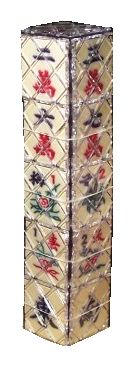
Figure 13: The two solved states of the Tower of Mahjong.
As seen in the tile-map above, there are three parts numbered from 1 to
9, four which represent the four seasons, four which represent four flowers,
four representing four winds, and three representing three dragons (total
of 42).
Most of them need some understanding of the Chinese characters, and the
placing of the tiles is not random at all.
The second solution (photos below) looks more like the style when four players have spread their Mahjong pieces on the table. It is a very elegant and carefully made puzzle. And because of its natural creme color (similar to the original Mahjong pieces), it looks as if it was made of ivory.
TO BE CONTINUED TO PART 2 (to be made soon)